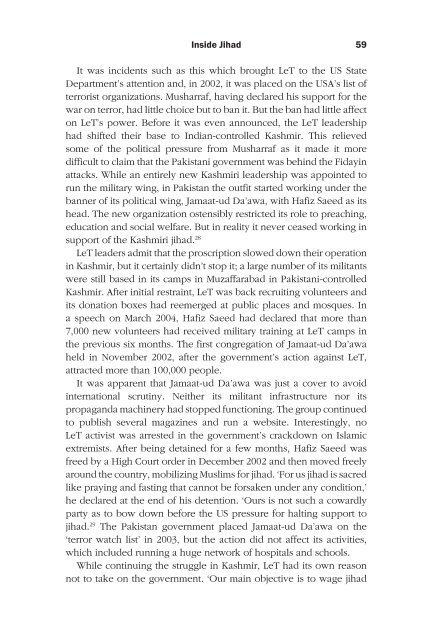Frontline Pakistan : The Struggle With Militant Islam - Arz-e-Pak
Frontline Pakistan : The Struggle With Militant Islam - Arz-e-Pak
Frontline Pakistan : The Struggle With Militant Islam - Arz-e-Pak
You also want an ePaper? Increase the reach of your titles
YUMPU automatically turns print PDFs into web optimized ePapers that Google loves.
Inside Jihad<br />
It was incidents such as this which brought LeT to the US State<br />
Department’s attention and, in 2002, it was placed on the USA’s list of<br />
terrorist organizations. Musharraf, having declared his support for the<br />
war on terror, had little choice but to ban it. But the ban had little affect<br />
on LeT’s power. Before it was even announced, the LeT leadership<br />
had shifted their base to Indian-controlled Kashmir. This relieved<br />
some of the political pressure from Musharraf as it made it more<br />
difficult to claim that the <strong><strong>Pak</strong>istan</strong>i government was behind the Fidayin<br />
attacks. While an entirely new Kashmiri leadership was appointed to<br />
run the military wing, in <strong><strong>Pak</strong>istan</strong> the outfit started working under the<br />
banner of its political wing, Jamaat-ud Da’awa, with Hafiz Saeed as its<br />
head. <strong>The</strong> new organization ostensibly restricted its role to preaching,<br />
education and social welfare. But in reality it never ceased working in<br />
support of the Kashmiri jihad. 28<br />
LeT leaders admit that the proscription slowed down their operation<br />
in Kashmir, but it certainly didn’t stop it; a large number of its militants<br />
were still based in its camps in Muzaffarabad in <strong><strong>Pak</strong>istan</strong>i-controlled<br />
Kashmir. After initial restraint, LeT was back recruiting volunteers and<br />
its donation boxes had reemerged at public places and mosques. In<br />
a speech on March 2004, Hafiz Saeed had declared that more than<br />
7,000 new volunteers had received military training at LeT camps in<br />
the previous six months. <strong>The</strong> first congregation of Jamaat-ud Da’awa<br />
held in November 2002, after the government’s action against LeT,<br />
attracted more than 100,000 people.<br />
It was apparent that Jamaat-ud Da’awa was just a cover to avoid<br />
international scrutiny. Neither its militant infrastructure nor its<br />
propaganda machinery had stopped functioning. <strong>The</strong> group continued<br />
to publish several magazines and run a website. Interestingly, no<br />
LeT activist was arrested in the government’s crackdown on <strong>Islam</strong>ic<br />
extremists. After being detained for a few months, Hafiz Saeed was<br />
freed by a High Court order in December 2002 and then moved freely<br />
around the country, mobilizing Muslims for jihad. ‘For us jihad is sacred<br />
like praying and fasting that cannot be forsaken under any condition,’<br />
he declared at the end of his detention. ‘Ours is not such a cowardly<br />
party as to bow down before the US pressure for halting support to<br />
jihad. 29 <strong>The</strong> <strong><strong>Pak</strong>istan</strong> government placed Jamaat-ud Da’awa on the<br />
‘terror watch list’ in 2003, but the action did not affect its activities,<br />
which included running a huge network of hospitals and schools.<br />
While continuing the struggle in Kashmir, LeT had its own reason<br />
not to take on the government. ‘Our main objective is to wage jihad













